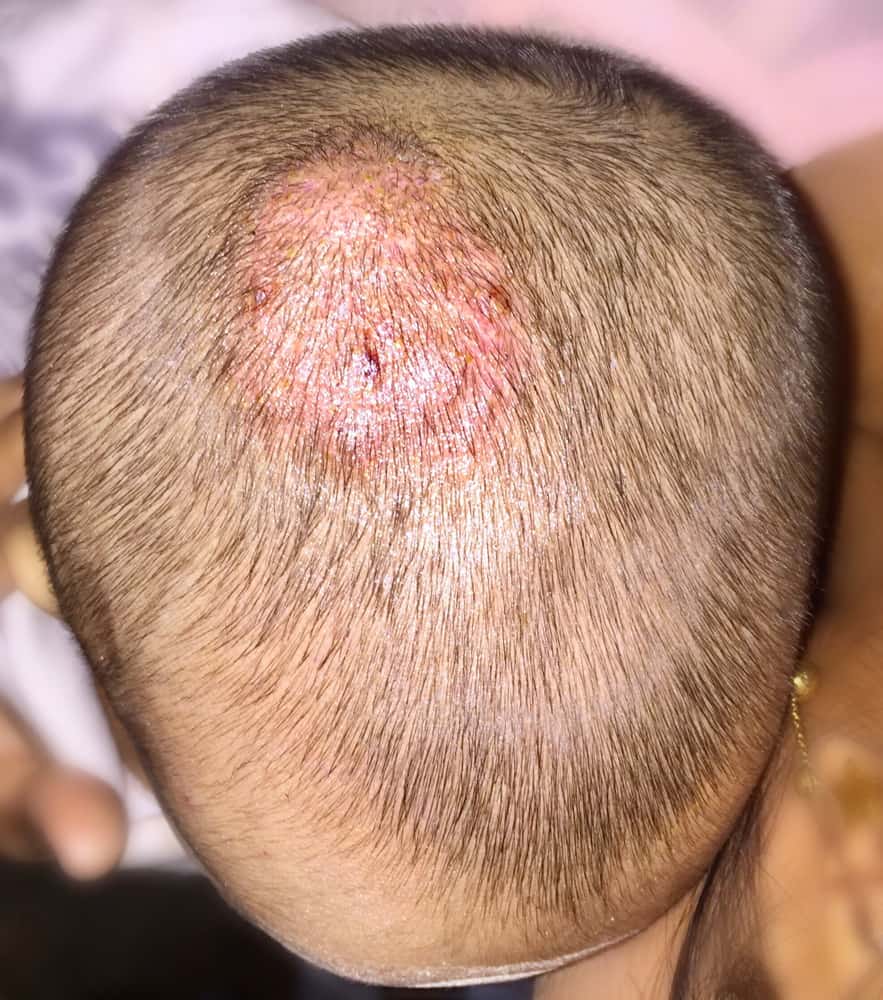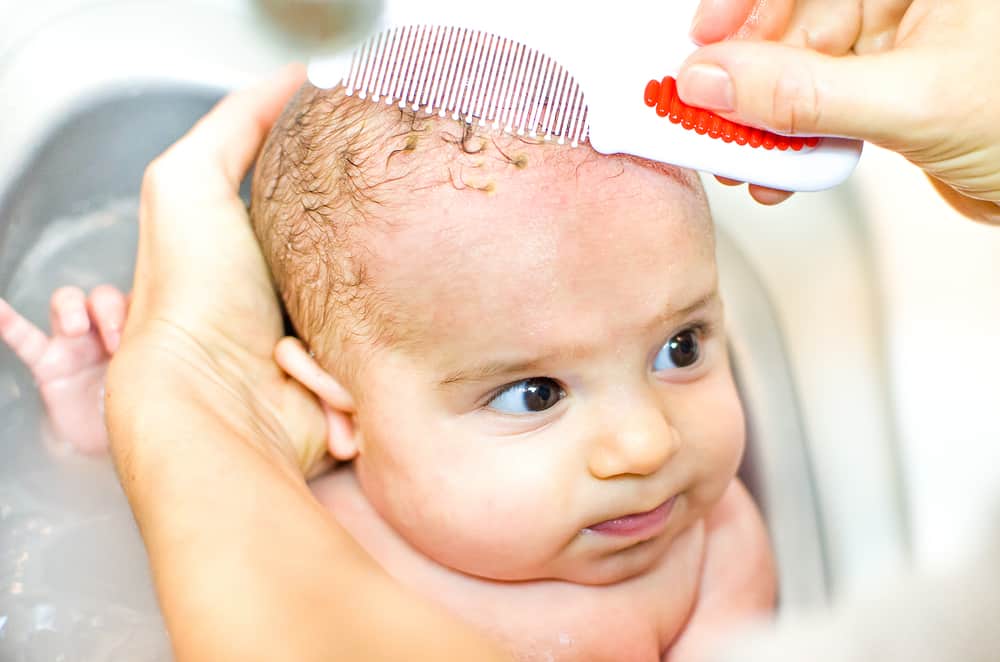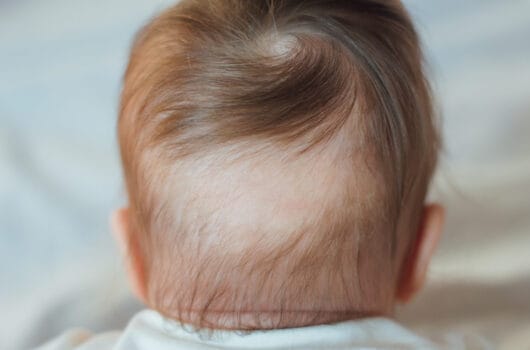The first few months of a baby’s life are full of changes and challenges, both expected and unexpected, as they bravely take their first small steps in a new world. As a new parent, you may have prepared yourself for any eventuality, but there are just some things that many parents never expect: like baby hair loss.
Remember when you first laid eyes on your little one and proudly thought he or she could rival Chewbacca in the hair department? Yes, some babies do come out sporting a shock of thick hair, but it’s not abnormal or a sign of any problems for them to lose it all quickly.
What Is Baby Hair Loss?

You may notice your baby’s hair shedding a lot more than usual. There may be hair strands all over your baby’s pillow, brush, and bathwater. There may or may not be a band-like bald patch, but your baby’s hair could look noticeably thinner, especially in the back.
Doctors call this condition Neonatal Occipital Alopecia (NOA). NOA is the most common form of hair loss in newborn babies. Although it’s worrisome to think your baby might be going bald before you are, experts agree that hair loss during the first 6 months of life is completely normal, and is rarely caused by a medical problem.
The timing and pattern of hair loss can differ, depending on sex, ethnicity, heredity, and nutrition. On average, babies start losing hair in their 8th week, and it’s typically mostly gone by their 12th week.
But don’t worry; this is all temporary. Your baby is more resilient than you think. They’re likely to sprout their new, permanent hairs in no time, usually by the 7th month, although it could take up to two years for hair to mature and thicken. Be warned though: mature hairs that grow may look nothing like your baby’s birth hair. Curly hair can grow back straight, and vice versa. Blond hair can give way to brown, and sparse hair can grow back thicker.
What Does Abnormal Baby Hair Loss Look Like?
If by 6 months your baby is still losing hair or still showing no signs of growing back their hair by their first birthday, you’re highly encouraged to air your concerns to your pediatrician. Other important telltale signs that your baby’s hair loss is abnormal and may warrant a visit to the doctor:
- Hair loss is sudden and severe
- Hair comes out in fistfuls
- Scalp is red, flaky and inflamed
- Your baby is sluggish or irritable
- Your baby isn’t gaining weight or has trouble feeding
How Common Is Hair Loss in Babies?
There are really no hard or reliable statistics on NOA. Some studies say that between 9 and 12% of newborns experience hair loss but this is likely to be an underestimate. Because some babies experience very mild hair loss that resolves on its own, parents tend to just forget about it. Some parents may not even notice that their baby is losing hair at all, which is completely understandable. This, however, can lead to under-reporting of cases, which is why we don’t really know yet how common this condition is.
Why Do Babies Lose Their Hair?
There’s been a lot of speculation as to why some babies lose part of their birth hair. For a long time, friction from their head rubbing against their pillow when they lie on their back too much has been the culprit. Chances are, you’ve read about this too in your go-to mom blogs. But newer research suggests a more physiological reason than an abnormal one.
Babies start growing hair follicles from front to back of their scalp in the 12th week of fetal life. By the 20th week, they have already formed all their hair follicles. At 22 weeks, scalp hair undergoes synchronous shedding (telogen) following the pattern in which they formed.
The shedding process repeats 12 weeks before delivery. By the time your baby is born, most of the hair follicles in the front have finished shedding, and are already actively growing (anagen). In some babies, the hair in the back doesn’t enter the shedding process until a few weeks after birth.
So when you see tufts of hair on your baby’s pillow a few weeks after birth, don’t panic; what you’re seeing is part of the natural hair cycle. Having your baby sleep on their back may seem to be the root problem, but the friction between the scalp and the pillow is only just aiding the hair shedding, not causing it.
Some experts also believe that the big hormonal shifts following childbirth could kick your baby’s hair follicles into the shedding phase prematurely. Called telogen effluvium, this condition can appear a few weeks after stressful and traumatic events like severe illness or childbirth.
Telogen effluvium is usually caused by an upsurge of cortisol during childbirth. This hormone diverts most of the body’s resources into life-sustaining functions essential for survival, and away from non-essential functions like hair growth.
Yet another theory is that a sharp drop in progesterone (yes, the same hormone which gives you Vogue-worthy hair that can give Gisele a run for her money) after birth can trigger telogen effluvium in both you and your baby.
Are Some Babies More Likely to Lose Their Hair?
Some studies have found NOA to be more common in babies who are Caucasian, born to mothers below 34 years of age, delivered vaginally, and/or born at full-term.
Medical Conditions That Can Cause Baby Hair Loss
If your baby still isn’t growing back hair or is still losing hair by their first birthday, there could be a more serious reason behind the hair loss.
Alopecia Areata
Alopecia areata is a chronic autoimmune condition in which the immune system attacks healthy hair. It causes your baby to lose hair in the early stages. The patches are smooth and typically round or oval but can take on many shapes. Most children grow their hair back within a year, but some go on to develop alopecia areata over their entire scalp. Around 50% of children will experience flare-ups of hair loss in the future. Although the condition can affect people of all ages, it rarely affects infants under 6 months of age.
Ringworm

If your child develops itchy and scaly patches of hair loss, it’s most likely ringworm. Ringworm, also called tinea capitis, isn’t actually a worm. It is a fungal infection of the scalp and is one of the most common causes of hair loss in children, especially African American children. Although it rarely affects children below 2 years of age, it is very contagious. It’s not uncommon for several family members who share clothes, combs, pillows, and hats to be infected with ringworm.
Cradle Cap

Does your baby have thick, crusty, oily yellow patches on their scalp? It could be cradle cap, a form of eczema called seborrheic dermatitis. Unlike ringworm, cradle cap is neither painful, itchy, or contagious. It affects 10% of babies between 3 weeks and 12 months. Mild cases clear up in weeks or months with diligent home care. Triggered by hormones that pass from mom to baby before birth, cradle cap causes the baby’s oil glands to produce too much oil.
Medical Treatments for Baby Hair Loss
You don’t have to pull your own hair out over your baby’s balding head. In babies below six months of age with NOA, all you can do is sit back, wait it out, and accept it as a natural part of growing up.
In all other circumstances, your baby’s pediatrician may refer you to a dermatologist who will run diagnostic tests to get to the bottom of the problem. The doctor may ask you a few questions to aid the diagnostic process. Once the dermatologist knows what’s wrong, they will come up with a treatment plan for you to try on your baby depending on the severity of the underlying problem and your baby’s age.
Alopecia Areata
Although there’s no cure for alopecia areata, steroid creams applied on your baby’s scalp may help to manage the condition. Depending on your child’s age, the dermatologist may allow the use of hair growth stimulators such as minoxidil and anthralin in addition to steroids.
Ringworm
Ringworm infection of the scalp involves a 6 to 8-week treatment with an oral antifungal called griseofulvin. Your doctor may also advise you to wash your baby’s scalp with an antifungal shampoo that contains either selenium or ketoconazole and leave it on for 5 minutes. Although medicated shampoo doesn’t kill the fungus, it can keep it from spreading.
Because ringworm is highly contagious, other children in the household must be treated simultaneously with the medicated shampoo, and refrain from sharing clothing items, hairbrushes and pillows. Animals in the home could be a source of re-infection, so a qualified veterinarian should treat them accordingly.
Cradle Cap
If your baby has cradle cap, treatment is optional because it usually resolves on its own. In the meantime, you need to wash your baby’s scalp with baby shampoo daily. Some doctors may recommend alternating baby shampoo with an anti-dandruff shampoo like Head & Shoulders. If daily shampooing doesn’t work, your baby’s doctor may recommend a 1% hydrocortisone cream or an antifungal shampoo that you can buy without a prescription.
Preventing Baby Hair Loss
Getting through a doctor’s appointment and receiving a definitive diagnosis is just half of the battle. Most of the battle happens at home, so every parent has to have a fool-proof action plan in their arsenal.
Here are some helpful tips to consider to prevent baby hair loss from occurring in the first place and to allow the hair to regrow after a diagnosis.
Don’t Wash Their Hair Daily
Babies normally produce little oil on their scalp. They also don’t get dirty frequently enough to require daily washing. Using shampoos daily can mess up your baby’s natural hair oils, making hair drier, more brittle, and prone to breakage. So unless your baby has a scalp infection, limit washing to 2-3 times per week with a mild and unscented baby shampoo. Or better yet, just use warm water.
Don’t Style Their Hair
Did you know that styling can damage hair? Styling your baby’s hair into ponytails or braids might look cute, but it can also accelerate hair loss. Baby hair is thin and sensitive; styling increases scalp tension, reducing blood flow that carries oxygen and nutrients to nourish your baby’s scalp and hair.
Don’t Pick at Their Scalp
We know well how satisfying it could be to pick at scabs and pop pimples, but when it comes to your baby’s cradle cap, there’s a better, safer way to get rid of the crusts. Instead of picking and pulling, apply mineral oil or coconut on the crusts for 15 to 30 minutes before bath time. The oil will soften the crusts, making them easier to remove. Come bath time, massage your baby’s scalp, or use a soft-bristled brush to peel off the softened crusts. Make sure to wash off all the oil because it can worsen your baby’s cradle cap if left on the scalp.
Final Thoughts
If your baby is showing other symptoms like redness, inflammation, and crusting, please set up an appointment with your baby’s doctor. Whatever is causing these symptoms can be treated or managed with the appropriate medications, and proper hair care.
But, for most babies, hair loss isn’t a sign of any problems. Some babies lose hair in the first months of their life, and that is completely normal, so there’s really no need to panic and go rushing to your baby’s pediatrician.
